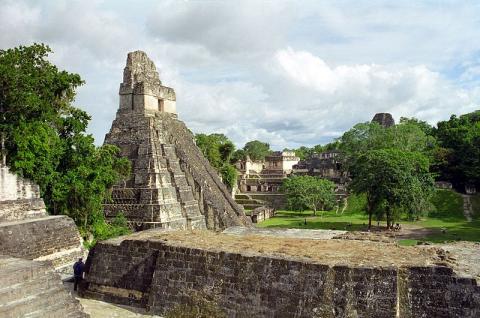
As a lay missioner I was fortunate enough to work in the Petén region of Guatemala, only 2.5 hours away from Tikal, the site of one of the greatest ancient Mayan cities. Tikal’s six temples have attracted tourists and archaeologists from around the world. For the native Mayans, who comprise over 50 percent of Guatemala’s population, Tikal is a sacred site built by their ancestors.
While serving in the parish of San Luis, I helped another lay missioner, Anne, organize a picnic in Tikal for the lay ministers of our parish. Early one morning all those involved in visiting the sick, singing in the choir, ministering to youth, teaching catechism, and promoting health and literacy packed up their picnic baskets and their families and climbed aboard three buses traveling north to Tikal. As soon as we arrived, only minutes after the buses were unloaded, several of the community’s elders gathered everyone in the center of Tikal’s main plaza. In that sacred spot, surrounded by four temples, they made their offering of gratitude, first by building a fire and placing on it pine needles, incense, cacao beans, flowers, and kernels of corn, then by kneeling reverently and saying their prayers of thanksgiving. The Q’eq’chi celebrate their connection to all of God’s creation, and give thanks to God for the ways in which the natural world supports them giving them water to drink, food to eat, sweet things to smell and beautiful scenery to appreciate. Theirs is a very sense-filled connection – seeing the embodiment of the divine in the natural world and in the sacred spaces where their ancestors built great temples and shrines.
The sacred connection to location and to the ancestors demonstrated that day filled my mind as I read today’s passage from Ezekiel, which refers to a holy place where God’s abundance is revealed.
For the Maya Q’eqchi’ with whom I worked, hallowed places mattered. When the war’s violence forced people to flee villages and hamlets, they were no longer able to go to the caves, rivers and mountains that their ancestors had designated as sacred places to offer prayers of petition and thanksgiving. These are the places where the Maya Q’eqchi’ feel in harmony with all of creation, the places where they feel closest to God. This is why when the war ended and people returned to their villages they were so hopeful. When reparations were discussed, it was difficult for people to name anything that could make up for such a great disruption to their sense of ecological balance, well-being and faith in the days when they were prevented from visiting those sacred places where they had most felt the presence of God’s Spirit.
For those of us who might not have the same sense of sacred space as the Mayan Q’eqchi’, today’s readings emphasize the importance of recognizing sacred places. For Paul, in today’s reading from Corinthians, we ourselves become those sacred places because God’s Spirit dwells within us. Paul writes: “Do you not know that you are God’s temple and that God’s Spirit dwells in you? If anyone destroys God’s temple, God will destroy that person. For God’s temple is holy, and you are that temple” (1 Cor. 3:16-17).
This is an interesting concept. My body actually IS the place where God’s Spirit dwells. Well, that certainly gives me a new framework for taking care of my physical body! Suddenly patterns I can fall into where I get too little sleep or eat too many sweets, or deprive myself of exercise take on new meaning!
At the same time, I believe today’s second reading challenges me to recollect that everyone I meet is also a temple of God. Remembering this gives me a new perspective on how much patience I have for the grocery store cashier who moves slowly in spite of my busy schedule, or how much compassion I feel for the homeless person who sings off key while she loudly shakes her can of coins next to my ears. It may even help me find some way of containing my judgment when I see a finely dressed man stepping out of a taxi in front of one of the biggest banks on Wall Street. I have to admit that this last example is the most challenging for me.
Today’s readings invite us to think about the sacred places in our lives where God is revealed to us, and we pray that we can recognize the importance of holy spaces like Ezekiel when the angel led him to the temple or like the Q’eqchi’s do when making their offerings at the ancient Mayan temples or when looking at the sacred spaces they recognize in rivers, mountains and caves.
Recognizing the sacred and affirming God’s Spirit within and among us is the way in which we feel the most harmony with God, with the rest of creation and with our ancestors who have gone before us. We are also challenged to think of our own bodies (and those of our neighbors) as places where God’s Spirit can dwell. This is not an easy challenge but one that will lead to great harmony and peace.
